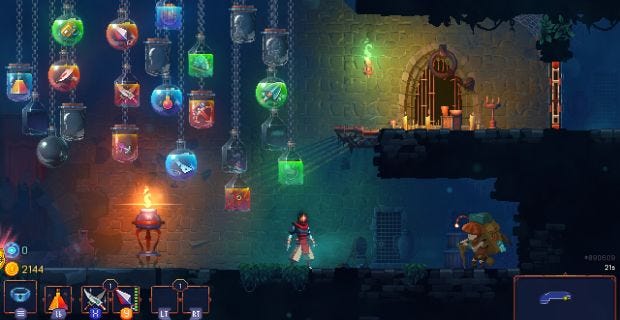Premature Evaluation: Dead Cells
Best celler
Every week we decapitate Brendan and throw him into the early access dungeons, and somehow he always comes back. He must have learned that trick from the promising and punishing Dead Cells [official site]
Life is good when you beat a boss. I’ve been toying with Dead Cells for the past week, relishing its roguelite slashing and crunchy pixel art. It’s a tough game, often punching you in the gut with powerful enemies and sending you slithering all the way back to the start with each death. But every time you die, you get stronger, along with a chance to re-roll the dice of fate to see what vicious weaponry you can gather this time. It styles itself after Dark Souls but, really, you should leave those assumptions at the gate. Just there, next to the pile of beheaded corpses.
First, the basics. You’re a blob of slimy green cells, but you’ve also taken over the cadaver of a beheaded prisoner, presumably because you need his arms for weapon-wielding purposes. This is how every new life starts, deep in the Prisoner’s Cells (see what they did there?) You get a crappy sword and a crappy shield and off you pop. Enemies drop cells of their own – big blue baubles – and you invest these in new powers when you reach the end of each level, thanks to a tall, creepy stranger who has a lab between each new area. You can get new weapons to start with, or magical spells like a freezing cone or lightning strike, among other skills and upgrades.
But you also need to find the blueprints to unlock those new skills and weapons, and you need to bring these blueprints to your new best friend, Creepy Man. In other words, you might find the coolest-looking terror machine – a buzzsaw trap or a “knifestorm” that launches poisonous daggers in every direction – but if you die before you hit the next “lab” you won’t unlock that device. You also lose all the cells you’ve gathered, and a huge chunk of gold (which you spend to buy weapons and skills from merchants or unlock special doors found within each level). And unlike Dark Souls, there’s no way to retrieve your cells, nor is there a way to go backwards, safely banking your pocket money before heading back out to do battle in what has now become your comfort zone. The doors to each lab lock behind you. You must always press on.
Reading it back, that sounds punishing. But I have rarely had a death which made me groan or flounder as much as any high-stakes battering the Souls series has dealt me. That’s because the leveling-up process itself is forgiving. You can pump cells into making any weapons more powerful and they will stay that way even after death. You can invest in a perma-bag that saves more gold upon dying (I’m currently pissing my cells into an expensive gold bag that saves 65% of my gold when I croak it, for example), or a bottle that holds more health potion, allowing you two or three slugs of lifejuice instead of just one. Once you start comfortably bringing back blueprints from the first two or three levels, the chance for better weapons also opens up like a yawning mouth. You start to get skills that compliment each other in ridiculous yet powerful ways.
To give you an example of how this works: you have two weapon slots and two skill slots. I often hold a sword in one hand and a set of throwing knives in the other. The knives normally just make enemies bleed, slowly reducing their health, but sometimes I find a special edition "knifestorm" that also makes adjacent enemies bleed if your first target dies. This causes a chain reaction of death, as foes start dropping in a horrible cascade of blood. On top of that, there’s a sword that does extra damage against bleeding enemies. Your entire get-up can be tailored to quickly drain the baddies dry. I once died with this set of items, losing almost fifty cells and plenty of gold and blueprints, but I wasn’t upset at those losses – only at the loss of a useful loadout, a relentless character build with pockets full of sharp objects. Blood Man.
I can see why the developers have marketed it as a “soulslike”. It has the death, the upgrading. It has taken the health bar idea from Bloodborne too - if you get smacked you still have a chance to suck up some of that lost health by quickly striking your opponent back, like a vengeful toddler trying to get even. In many ways it does have a faster-paced Souls feeling. But it also encourages speed in other ways. There are doors that only stay open for a certain amount of time, leading to extra treasure, for example (although I tend to ignore these). And the sheer quantity of enemies on-screen in some of the later levels means that you will often be rolling and jumping and diving and stabbing in a rampant, violent panic, until either you die or the screen is emptied.
But most importantly, the controls are pixel-perfect. Just that makes you want to move fast – because it’s fun. They’re designed to be used with precision, and the enemies are consistent and predictable even if they are often collected into challenging groups or placed in awkward areas. You have to quickly learn their behaviours, and which creatures to prioritise – this is more or less the whole game. Knowing what to kill first and how best to kill it. Archers can be felled by rolling under their arrow and quickly slashing them. Bats can be quickly dispatched with a quick throwing knife or a whip. Other flying creatures need to be dealt with via grenades, because they swarm and inflict nasty damage if even one gets close. Slimy lampreys release half a dozen exploding eggs upon death, so you need to leave room for an escape after taking them down. Fat men throw axes. White ape-things teleport.
All of these small bits of tactical knowledge come to you over time and race through your head unconsciously as you roll around and slice things up. It’s as much a game of body memory as it is one of getting lucky with your instruments. And you will have enemies who you absolutely despise, as well as “elite” enemies who grow in power as their health depletes and take on new abilities they wouldn’t normally have. Like the power to zap right next to you when you're trying to escape.
I’ve played about 12 hours and have still only beaten one boss. There are only about ten levels for now and two bosses. But I’ve been ignoring a whole half of the game so far, because I’m afraid to go into the sewers. On top of that the levels can be large and they take time to unveil and explore – something essential for collecting the gear you want and the occasional power-up that increases your damage or health bar size. They also shift around, thanks to a semi-procedural generation trick. You’ll see the same “chunks” of levels again and again, but arranged in slightly different ways. It lends an odd feeling of familiarity to each level, you begin to know what to expect from the shape of the place, despite there being some randomisation to it all, like walking down your old high school corridor. It’s mostly the same, but you don’t remember all those spikes being there.
If there are complaints, it will be from people who tire of seeing these same areas again and again, even if they are shuffled. Sometimes the rooms meld together in less-than-ideal ways too, leaving you exploring to the bottom of a deep basement for no reason, or stuck in a flooded chamber where you have to jump and awkwardly roll in mid-air to get out through a tiny gap in the wall – one of the few instances where your character does not feel able and nimble. But these are infrequent moments. Mostly, the levels are warrens that you can vaguely recognise and predict.
As much as it wants to be seen as the bastard child of Castlevania and Dark Souls, it’s closer in atmosphere and challenge to another game: Risk of Rain. This is not a complaint, because Risk of Rain was excellent, and this is shaping up to be just as good. If it only adds more levels, bosses and enemies, it would be an easy recommendation. But new weapons and tricks are also planned. You’ll be able to combine electric whips with pools of water to shock enemies, for example, or combine fire weapons with hot oil.
There's much to like that I haven't even mentioned: that satisfying stomp attack, the relief of an ice grenade, clever and useful teleporter placement, key items that unlock whole new sets of levels, secret areas opened with runestones, cursed chests that give you a powerful item but leave you vulnerable to one-hit kills (and who goad and tease you as you pass them). Even busting through a door and using the shards to stun your enemies is deeply satisfying. It’s a hugely mechanically literate videogame, if that makes any sense, absorbing the tissue from a library of sources and somehow smooshing them together until only a single rock-solid figure remains, quick on its feet and dripping with viscera. When I first received a press release about it, I frowned at the term "roguevania", being instinctively hostile to the hybrid phrases birthed by developers and PR folk, like so many slimy chimeras. But for once, Dead Cells is worthy of its own invention. It's not just a roguevania - it's a damn good roguevania.
Dead Cells is on Steam for £13.99/$16.99. These impressions are based on build 1822784















